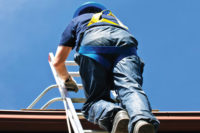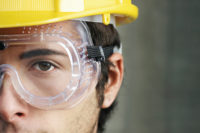
By definition, a “fall arrest system” consists of an anchorage connector, a body harness, a lanyard, deceleration device, lifeline, or a suitable combination of these. This article will discuss one such deceleration device, “The retractable lanyard.” What is it? How should it be used properly and safely? What are its advantages? Are there disadvantages?
Advantages of retractables
OSHA defines a “retractable” as a deceleration device containing a drum-wound line which can be slowly extracted from, or retracted onto, the drum under slight tension during normal employee movement, and which, after onset of a fall, automatically locks the drum and arrests the fall.
Retractable lanyards can be used when working on high buildings, chimneys, bridges, roofs and other workplaces involving fall hazards. They may be chosen over standard six-foot shock-absorbing lanyards for at least a couple of reasons. A self-retracting lanyard allows the worker freedom of movement, not possible with a sixfoot shock absorber. Once tied off to an anchorage point, he can move around easily to accomplish his task.
Of even more importance, consider this: Traditional six-foot shock-absorbing lanyards allow for up to 6 feet of freefall distance prior to activating, and another 3 ½ feet of the deceleration distance prior to arresting a fall. Self-retracting lanyards require less than 2 feet to arrest freefalls and they slowly pull out to a maximum of 54 inches, creating a minimum of impact and stress to the body. With shorter activation distance and shorter overall arresting distance, self-retracting lanyards reduce the risk of hitting the ground or any obstructions at a lower level.
Functionally, a retractable is similar to the seatbelt in your car. A restoring spring keeps the wire rope or Polyamide strap taut, allowing it to respond immediately in the event of a fall. When the working speed (approximately 4 ½ feet per second) is exceeded, the brake pawls activate the brake system, locking into place as a result of centrifugal force. The required fall absorption is attained by a disc brake system which is set internally. Brake values are independent of any weather situation. Retractables are tested in extreme conditions, e.g. cold, heat and moisture.
DIN-tested units
Retractables that are 100 percent tested according to the requirements of DIN EN 360 are tested for:
- Design and ergonomics
- Materials and construction
- Blocking after pre-treatment; blocking in the horizontal position
- Static load bearing capacity, static load bearing for horizontal applications
- Dynamic performance, dynamic performance for horizontal applications, dynamic load bearing capacity for horizontal applications
- Optional requirement in respect to fatigue strength
- Corrosion resistance
- Identification and information
The draft requires that all retractables are tested in horizontal as well as a vertical use. They are also specifically tested for falls over a sharp edge.
All retractables are not alike
Some of the retractables on the market are not approved for over-the-edge drops or foot level drops. However, those meeting the DIN Standard are approved for these drops. European iron workers walk the iron with a small retractable at foot level to avoid lower-level contact. This is possible because a good disc brake mechanism inside the unit acts like a shock absorber to absorb this extreme kind of impact.
Fifty of these DIN-approved units were in use when an inspector had them all pulled off the job, because a synthetic shock was not attached to the unit as some manufacturers recommend for foot level drops. A test was quickly set up. A 1-inch steel plate was placed 5 feet above the edge and dropped. It worked perfectly. The test was successfully completed three times with the same unit. A DVD of the test was sent to the user. However, the inspector said that it was trick photography and it would not be allowed. After a few meetings with the inspector’s supervisor, common sense prevailed and the DINapproved retractables were back in service. The inspector was only trying to avoid an accident. Other retractables had failed in the field in this application.
Swing hazard
Is there a disadvantage to the use of a retractable? The freedom of motion offered by the retractable accentuates a swing or pendulum hazard. If involved in a fall while using a shock-absorbing lanyard or retractable and with an anchorage point that is not positioned directly overhead, a swing fall or pendulum effect will occur. Striking an object while swinging can lead to serious injury. Since self-retracting lanyards allow for greater horizontal and vertical mobility than standard six-foot shock absorbing lanyards, extra care should be taken to reduce swing falls. To me this “disadvantage” is simply a condition that must be noted when using any fall protection system. Use it correctly, and it will operate correctly.


